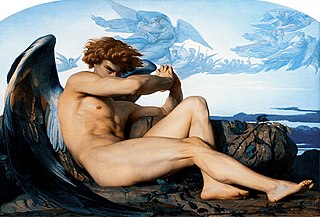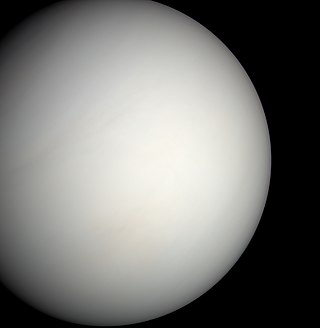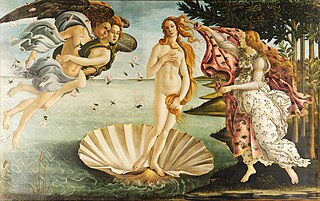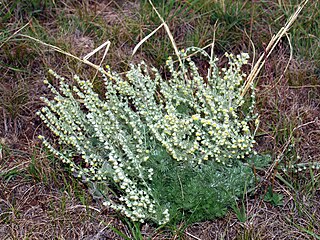
Aphrodite is an ancient Greek goddess associated with love, lust, beauty, pleasure, passion, procreation, and as her syncretized Roman goddess counterpart Venus, desire, sex, fertility, prosperity, and victory. Aphrodite's major symbols include seashells, myrtles, roses, doves, sparrows, and swans. The cult of Aphrodite was largely derived from that of the Phoenician goddess Astarte, a cognate of the East Semitic goddess Ishtar, whose cult was based on the Sumerian cult of Inanna. Aphrodite's main cult centers were Cythera, Cyprus, Corinth, and Athens. Her main festival was the Aphrodisia, which was celebrated annually in midsummer. In Laconia, Aphrodite was worshipped as a warrior goddess. She was also the patron goddess of prostitutes, an association which led early scholars to propose the concept of "sacred prostitution" in Greco-Roman culture, an idea which is now generally seen as erroneous.

Lucifer is the Latin name for the morning appearances of the planet Venus. It corresponds to the Greek names Phosphorus Φωσφόρος, "light-bringer", and Eosphorus Ἑωσφόρος, "dawn-bringer". The entity's Latin name was subsequently absorbed into Christianity as a name for the devil. Modern scholarship generally translates the term in the relevant Bible passage, where the Greek Septuagint reads ὁ ἑωσφόρος ὁ πρωὶ, as "morning star" or "shining one" rather than as a proper noun, Lucifer, as found in the Latin Vulgate. The word "Lucifer" appears in The Second Epistle of Peter in the Latin Vulgate to refer to Jesus. The word "Lucifer" is also used in the Latin version of Exsultet, the Easter proclamation.

Venus is the second planet from the Sun. It is a rocky planet with the densest atmosphere of all the rocky bodies in the Solar System, and the only one with a mass and size that is close to that of its orbital neighbour Earth. Orbiting inferiorly, it appears in Earth's sky always close to the Sun, as either a "morning star" or an "evening star". While this is also true for Mercury, Venus appears much more prominently, since it is the third brightest object in Earth's sky after the Moon and the Sun, appearing brighter than any other star-like classical planet or any fixed star. With such prominence in Earth's sky, Venus has historically been a common and important object for humans, in both their cultures and astronomy.

Venus is a Roman goddess, whose functions encompass love, beauty, desire, sex, fertility, prosperity, and victory. In Roman mythology, she was the ancestor of the Roman people through her son, Aeneas, who survived the fall of Troy and fled to Italy. Julius Caesar claimed her as his ancestor. Venus was central to many religious festivals, and was revered in Roman religion under numerous cult titles.

The Venus de Milo or Aphrodite of Melos is an ancient Greek sculpture that was created during the Hellenistic period. It is one of the most famous works of ancient Greek sculpture, having been prominently displayed at the Louvre Museum since shortly after the statue was rediscovered on the island of Milos, Greece, in 1820.

The Birth of Venus is a painting by the Italian artist Sandro Botticelli, probably executed in the mid 1480s. It depicts the goddess Venus arriving at the shore after her birth, when she had emerged from the sea fully-grown. The painting is in the Uffizi Gallery in Florence, Italy.

Phosphorus is the god of the planet Venus in its appearance as the Morning Star. Another Greek name for the Morning Star is "Eosphorus", which means "dawn-bringer". The term "eosphorus" is sometimes met in English. As an adjective, the word "phosphorus" is applied in the sense of "light-bringing" and "torch-bearing" as an epithet of several gods and goddesses, especially of Hecate but also of Artemis/Diana and Hephaestus. Seasonally, Venus is the "light bringer" in the northern hemisphere, appearing most brightly in December, signalling the "rebirth" of longer days as winter wanes.

The Rokeby Venus is a painting by Diego Velázquez, the leading artist of the Spanish Golden Age. Completed between 1647 and 1651, and probably painted during the artist's visit to Italy, the work depicts the goddess Venus in a sensual pose, lying on a bed with her back facing the viewer, and looking into a mirror held by the Roman god of physical love, her son Cupid. The painting is in the National Gallery, London.

The phases of Venus are the variations of lighting seen on the planet's surface, similar to lunar phases. The first recorded observations of them are thought to have been telescopic observations by Galileo Galilei in 1610. Although the extreme crescent phase of Venus has since been observed with the naked eye, there are no indisputable historical pre-telescopic records of it being described or known.

Kamisama Kazoku is a Japanese anime series based on a series of light novels by Yoshikazu Kuwashima, which premiered May 18, 2006 in Japan across the anime satellite television network Animax. The original light novel series has concluded with eight volumes; however, a sequel light novel series titled Kamisama Kazoku Z (神様家族Z) was released on January 25, 2008.

Jeremiah Horrocks, sometimes given as Jeremiah Horrox, was an English astronomer. He was the first person to demonstrate that the Moon moved around the Earth in an elliptical orbit; and he was the only person to predict the transit of Venus of 1639, an event which he and his friend William Crabtree were the only two people to observe and record. Most remarkably, Horrocks correctly asserted that Jupiter was accelerating in its orbit while Saturn was slowing and interpreted this as due to mutual gravitational interaction, thereby demonstrating that gravity's actions were not limited to the Earth, Sun, and Moon.

In classical mythology, Cupid is the god of desire, erotic love, attraction and affection. He is often portrayed as the son of the love goddess Venus and the god of war Mars. He is also known as Amor. His Greek counterpart is Eros. Although Eros is generally portrayed as a slender winged youth in Classical Greek art, during the Hellenistic period, he was increasingly portrayed as a chubby boy. During this time, his iconography acquired the bow and arrow that represent his source of power: a person, or even a deity, who is shot by Cupid's arrow is filled with uncontrollable desire. In myths, Cupid is a minor character who serves mostly to set the plot in motion. He is a main character only in the tale of Cupid and Psyche, when wounded by his own weapons, he experiences the ordeal of love. Although other extended stories are not told about him, his tradition is rich in poetic themes and visual scenarios, such as "Love conquers all" and the retaliatory punishment or torture of Cupid.

Michael Venus is a New Zealander professional tennis player. He has a career-high doubles ranking of world No. 6, achieved on 29 August 2022. Venus won the 2017 French Open men's doubles partnering Ryan Harrison, and followed with a runner-up finish in the 2017 US Open mixed doubles partnering Chan Hao-ching. Venus and Harrison qualified for the year-end championships ATP Finals, where they reached the semifinals.

Coelopa frigida is a species of seaweed fly or kelp fly. It is the most widely distributed species of seaweed fly. It can be found on most shorelines in the temperate Northern Hemisphere. Other species of seaweed flies include Coelopa nebularum and Coelopa pilipes. C. frigida feeds primarily on seaweed, and groups of C. frigida flies tend to populate near bodies of water. Climate change has led to an increase in C. frigida blooms along shores, which creates a pest problem for human beach-goers. C. frigida is also an important organism for the study of sexual selection, particularly female choice, which is influenced by genetics.

Venus with a Mirror is a painting by Titian, now in the National Gallery of Art in Washington, DC, and it is considered to be one of the collection's highlights.

Artemisia frigida is a widespread species of flowering plant in the aster family, which is known as the sunflower family. It is native to Europe, Asia, and much of North America. In parts of the north-central and northeastern United States it is an introduced species.

The first known observations and recording of a transit of Venus were made in 1639 by the English astronomers Jeremiah Horrocks and his friend and correspondent William Crabtree. The pair made their observations independently on 4 December that year ; Horrocks from Carr House, then in the village of Much Hoole, Lancashire, and Crabtree from his home in Broughton, near Manchester.

Sine Cerere et Baccho friget Venus, or Sine Cerere et Libero friget Venus, is a quotation from the Roman comedian Terence that became a proverb in the Early Modern period. Its simplest level of meaning is that love needs food and wine to thrive. It was sometimes shown in art, especially in the period 1550–1630, in Northern Mannerism in Prague and the Low Countries, as well as by Rubens.

Coelopa pilipes is a common European species of kelp fly. It was described by A. H. Haliday in 1838. Their appearance differs greatly from that of other Coelopa flies.

The magical Girdle of Aphrodite or Venus, variously interpreted as girdle, belt, breast-band, and otherwise, is one of the erotic accessories of Aphrodite, the Greek goddess of love and beauty. According to Homer, the girdle was imbued with the power to inspire the passion of desire in mortals and immortals alike. Hera, in her role as the goddess of marriage, sometimes borrowed it from Aphrodite to mitigate lovers' quarrels, to instigate the bridal contests of suitors, and on at least one occasion to manipulate her husband Zeus.




















